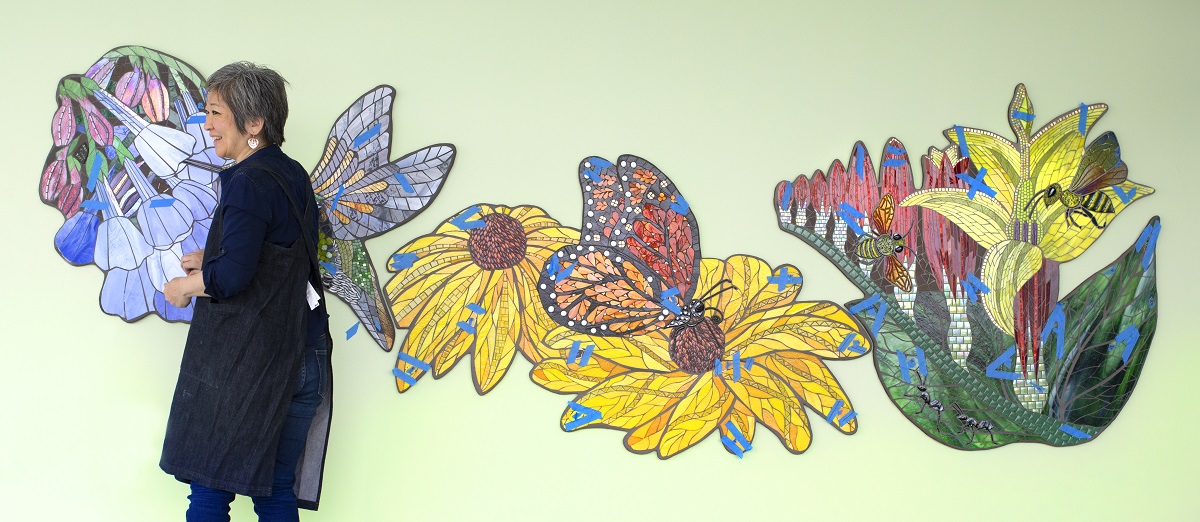Healing hello for patients and visitors at new Hampden Medical Center: Art

By Carolyn Kimmel
Excellent health care is more than a stellar team of medical experts – it’s a feeling of welcome and connectivity to the place where it’s received.
With that in mind, the Hampden Art Committee – an intentionally diverse, 14-member community group – researched what types of art would be most pleasing to patients and hand-picked some 400 pieces of art for the new Penn State Health Hampden Medical Center.
“When people walk through the door, we want them to feel that, ‘This is a place for me. I am welcome here This art was made for people like me,’” said Claire de Boer, founding director of Center Stage Arts in Health, which provides arts programming to nourish well-being throughout the Penn State Health Milton S. Hershey Medical Center and Penn State College of Medicine community, and coordinator of the committee.
Usually the architectural firm that designs a building procures stock art, but “Hats off to our leadership for recognizing it’s way more personable to have it hand-selected by people who are potential viewers and in a collaborative process that builds community,” de Boer said.
Partnering with Lynette Chappell-Williams, vice president and chief diversity officer at Penn State Health, de Boer wanted at least 50% of the committee members to be people who represent diversity. The resulting group, which includes representatives from education, business, faith, medicine and public service sectors, is more than 90% diverse, she said.
“The community surrounding Hampden Medical Center is mainly white, but there’s plenty of diversity in the counties the hospital will serve, which include Dauphin, Cumberland, York, Perry and Juniata,” de Boer said. “And, as time progresses, the community immediately around the medical center will become increasingly diverse.”
Cynthia Lester-Moody, a Hampden Art Committee member and a Black/African-American woman who works as an operations delivery director at United Concordia, said when she enters a medical center, she first notices the facility’s appearance and the clinicians – ‘Do the clinicians and environment reflect who I am, as well as the other patients?’ – all of which feeds into a sense of feeling comfortable and makes the experience seem less intimidating.
“Being on the Hampden Art Committee has expanded my knowledge about how art in a health care center impacts patients’, caregivers’ and clinicians’ ability to deal with health issues,” she said. “The impact is more synergistic when the artwork reflects the people in the community.”
The Hampden Art Committee wrote guiding principles for the art they wanted and produced a call for artists to encourage people from historically marginalized cultures to apply, de Boer said.
Their efforts couldn’t be more timely.
“This is a time where we are learning how much we’ve excluded people, often unconsciously,” de Boer said. “It’s a step forward to dismantling some of that nuanced exclusion.”
Many artists of color don’t know of opportunities to show their work because they aren’t in the networks where they might hear about them, and the structural process itself can be a barrier, said Ophelia Chambliss, a Hampden Art Committee member and Black/African-American artist whose paintings and large-scale murals can be seen throughout Pennsylvania.
“It is important that people of color are able to self-represent in art and depict, through their own lens, themselves and the world they live in,” she said.
She and other committee members personally invited minority artists to apply and offered help with the process.
Community donors underwrote the cost of commissioned artwork installed at Health Hampden Medical Center. In addition to an anonymous donor, benefactors include: Paul and Alison Coppock of Enola; Carole DeSoto of Lemoyne; Marilyn Kauffman of Dornsife; and David Skerpon and Chris Baldrige of Harrisburg.
Perhaps surprisingly to some, another important reason to be intentional about the medical center’s art is that it may have the power to address health disparity by making people feel at home enough to seek preventative care, de Boer said.
“Absolutely, to a segment of people in the community, the ER is the doctor’s office,” Moody agreed. “If they feel more comfortable because of the art outside their primary care doctor’s office and other motivators, it can help transform how people view healthcare.”
Agreed Chambliss, “So much of what Black and brown people are concerned with is whether or not they belong in a space. The decision becomes a lot easier if you are made to feel like you are going to be heard.”
Visiting a hospital may feel overwhelming or stressful, and art has a way of easing these tensions, de Boer said. “Art speaks to our emotions – beautiful art helps soothe, engage and calm patients, staff and visitors,” she said.
Hampden Medical Center President Donald McKenna said de Boer’s experience in integrating art into the healing process has tremendous value for those being served. “Claire’s passion and keen knowledge for the arts as well as her experience in this field gives me great confidence in knowing Hampden Medical Center will look and feel amazing,” he said.
To learn more about supporting public art at Penn State Health facilities or the role of the arts in healing, contact the Office of Development at 717-531-8497 or giving@pennstatehealth.psu.edu.
If you're having trouble accessing this content, or would like it in another format, please email Penn State Health Marketing & Communications.
